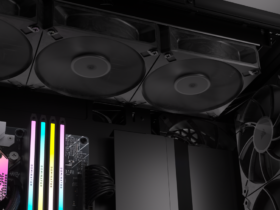
Lenovo extends its project with the Leibniz Supercomputing Center (LRZ), kicking off phase two of the next-generation supercomputer. Phase two will see the integration of AI-based computing into the current high-performance computing (HPC) system, SuperMUC-NG
Lenovo Infrastructure Solutions Group, Intel and the Leibniz Supercomputing Center (LRZ) of the Bavarian Academy of Sciences, announce Phase Two of the SuperMUC-NG supercomputer of the LRZ. The system will provide users with integrated high-performance solutions, using artificial intelligence to implement advanced simulations, models and data analysis to accelerate research aimed at solving humanity’s greatest challenges. Thanks to investments by the Bavarian state and the German Federal Ministry of Education and Research, phase two will see an expansion of the SuperMUC-NG, part of the Gauss Center for Supercomputing (GCS), which will allow the system to remain one of the fastest and most efficient supercomputers in the world.

Lenovo’s Artificial Intelligence will enable integrated solutions
Since the launch of phase one of the SuperMUC-NG operators have used the supercomputer for both traditional simulation and modeling operations, both to automate the recognition of images and recurring shapes in the observation of the planet, medical images, health and demographic data. In light of the success of using SuperMUC-NG in these projects, the demand for high-performance data analytics, machine learning and fast memory has grown further.

To accommodate these demands and ensure support for researchers, the SuperMUC-NG will be enhanced with next generation Intel Xeon Scalable processors (codenamed Sapphire Rapids) and with the new GPU for HPC Intel based on the Xe HPC architecture, codenamed “Ponte Vecchio”. Phase Two will also use a sistema DAOS (Distributed Asyncronous Object Storage), which will run 3rd generation Intel Xeon Scalable processors (codenamed Ice Lake) and will be integrated into the Lenovo ThinkSystem SR630 V2 platform. The DAOS will provide one petabyte of data storage and will enable rapid throughput of large volumes of data, while the system architecture can handle compute-intensive and highly scalable workloads as well as artificial intelligence applications. Overall, the SuperMUC-NG Phase Two compute nodes will deliver four times the performance per Watt (High Performance Linpack) compared to phase one. Scott Tease, Vice President, HPC and AI, Lenovo Infrastructure Solutions Group, explains:
The Leibniz Supercomputing Center has long been an important innovation partner of both Lenovo and Intel. Phase two is an exciting opportunity to share our experience in what Lenovo calls’Exascale for Everyscale‘, solutions that use advanced exascale technologies in clusters of all sizes, and provide researchers with the specialized resources they need to accelerate their projects. With the implementation of our Neptune warm water cooling system and an integrated system for artificial intelligence and deep learning, LRZ can continue to be a leader in advanced technologies for many years and set new standards in research and development.
Ensure a sustainable approach
The improvements made in phase two will allow the SuperMUC-NG to perform new tasks in the most energy efficient way. This is possible thanks to the integration of 240 Intel compute nodes into the ThinkSystem SD650 from Lenovo that takes advantage of Neptune warm water cooling and connects to the DAOS storage system via a high-speed network. Lenovo’s innovative Neptune direct water cooling technology removes about 90% of the heat from the system, reducing overall power consumption, significantly increasing overall efficiency and allowing processors to perform at their best. In addition, SuperMUC-NG components will be manufactured in Europe, at Lenovo’s new dedicated manufacturing facility in Hungary, to help further improve the project’s ecological footprint through a shorter supply chain. Prof. Dr. Dieter Kranzlmüller, director of LRZ, comments:
Providing resources and services that enable researchers to accelerate their projects is at the heart of everything we do at LRZ. Our work with Lenovo and other partners to integrate advanced AI capabilities in this new phase will help the center achieve this and provide researchers with what they need to excel in their fields. Not only that, but with Lenovo’s lukewarm water cooling technology we are able to deliver these improvements in the most sustainable and energy efficient way possible.

Phase two launch
LRZ will receive the DAOS storage system in the last quarter of 2021 and the compute system will follow in the second quarter of 2022. The LRZ team is preparing its user community for the transition to phase two by offering support and consultancy for the adaptation and optimization of codes and algorithms for artificial intelligence and provide researchers with access to specialized GPU systems for artificial intelligence applications. The LRZ training program also offers a wide variety of machine and deep learning courses to update users on how to adapt existing algorithms or develop and train their own. SuperMUC-NG is currently al 15th place in the Top 500 of the most powerful supercomputers in the world. That’s all from the hardware section, keep following us!
The article SuperMUC-NG: Lenovo’s supercomputer at the Leibniz Supercomputing Center comes from TechGameWorld.com.















Leave a Reply
View Comments